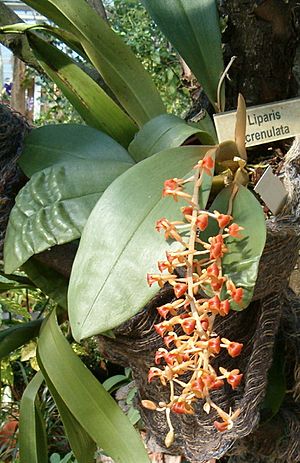Widelip orchids facts for kids
Quick facts for kids Liparis |
|
|---|---|
 |
|
| Liparis crenulata in the Berlin Botanical Garden | |
| Scientific classification |
|
| Kingdom: | Plantae |
| Clade: | Tracheophytes |
| Clade: | Angiosperms |
| Clade: | Monocots |
| Order: | Asparagales |
| Family: | Orchidaceae |
| Subfamily: | Epidendroideae |
| Tribe: | Malaxideae |
| Subtribe: | Malaxidinae |
| Genus: | Liparis Rich. |
| Type species | |
| Liparis loeselii (L.) Rich.
|
|
| Species | |
|
See text |
|
| Synonyms | |
|
|
Liparis is a large group of over 350 types of orchids. They are also known as widelip orchids or sphinx orchids. You can find these plants all over the world, except in Antarctica.
These orchids can grow in different ways. Some are terrestrial, meaning they grow in the ground. Others are lithophytic, growing on rocks. Some are epiphytic, which means they grow on other plants, like trees, but they don't harm them.
Liparis flowers are usually small to medium-sized. They often have colors like yellow, yellow-green, or purple. Their petals and sepals (which look like petals) spread out. A special part of the flower, called the labellum, is usually bigger than the other petals. It often has a wavy or toothed edge and small bumps called calli at its base.
Contents
What Liparis Orchids Look Like
Liparis orchids are herbs, which means they don't have woody stems. They usually have one or a few leaves. These leaves can be long and thin, or shaped like an egg. They might be thin or thick and leathery. Sometimes, the leaves are even pleated, like a fan.
The flowers grow on a stem with small leaf-like parts called bracts. The flowers are typically small to medium in size. They often point downwards and can be dull yellow, yellow-green, or purplish. Some even have a smell that isn't very pleasant.
The sepals and petals of the flower usually turn downwards. The top sepal (called the dorsal sepal) is separate. However, the side sepals (called lateral sepals) sometimes join together for part of their length. The petals are separate from each other and can look different from the sepals in size and shape.
The labellum, which is a modified petal, is usually larger than both the sepals and other petals. It often has a wavy or toothed edge. At its base, there are usually one or two small bumps called calli. These orchids have two pairs of waxy, oval pollinia, which are packets of pollen. Each pollinium has a sticky part called a viscidium.
How Liparis Got Its Name
The group of plants called Liparis was first officially described in 1817. This was done by a scientist named Louis Claude Richard. He published his description in a book called Die Orchideis Europaeis Annotationes.
The name Liparis comes from an Ancient Greek word, liparos. This word means "oily," "greasy," "sleek," or "shiny." This name likely refers to the smooth leaves that many of these orchids have.
Where Liparis Orchids Grow
You can find Liparis orchids on every continent except Antarctica. They grow in warm, tropical parts of Asia, and in both subtropical and tropical areas of the Americas. They are also found in Africa, New Guinea, and Australia.
There are many different types of Liparis orchids in various countries:
- China has sixty-three different species. Twenty of these are endemic, meaning they are only found in China.
- North America has two species.
- Europe has one species.
Some Types of Liparis Orchids
- Liparis angustilabris (F.Muell.) Blaxell – Found in Queensland
- Liparis bautingensis Tang & F.T.Wang – Found in China
- Liparis bracteata T.E.Hunt – Found in Queensland
- Liparis coelogynoides (F.Muell.) Benth. – Found in N.S.W., Qld.
- Liparis condylobulbon Rchb.f. – Found from Taiwan and Indochina to the south-west Pacific
- Liparis crenulata (Blume) Lindl. – Found in Indonesia
- Liparis elegans Lindl. – Found in Indonesia, New Guinea
- Liparis fissipetala Finet – Found in China
- Liparis fleckeri Nicholls – Found in Qld.
- Liparis goodyeroides Schltr. – Found in Africa
- Liparis habenarina (F.Muell.) F.Muell. ex Benth. – Found in Australia
- Liparis hawaiensis (Blume) Lindl. – Found in the Hawaiian Islands
- Liparis hostifolia (Koidz.) Koidz. ex Nakai – Found in Japan
- Liparis latifolia Lindl. – Found in China, Southeast Asia, the Philippines, New Guinea
- Liparis liliifolia (L.) Rich. ex Lindl. – Found in North America
- Liparis loeselii (L.) Rich. – Found in Europe, Asia, North America
- Liparis nervosa (Thunb.) Lindl. – Found in Asia, Africa, America
- Liparis nugentiae F.M.Bailey – Found in Qld.
- Liparis petricola (D.L.Jones & B.Gray) Bostock – Found in Qld.
- Liparis pingxiangensis L.Li & H.F.Yan – Found in China
- Liparis reflexa (R.Br.) Lindl. – Found in N.S.W.
- Liparis sanamalabarica P.M.Salim – Found in India
- Liparis simmondsii F.M.Bailey – Found in Qld.
- Liparis swenssonii F.M.Bailey – Found in N.S.W., Qld.
See also
 In Spanish: Liparis (Orchidaceae) para niños
In Spanish: Liparis (Orchidaceae) para niños

